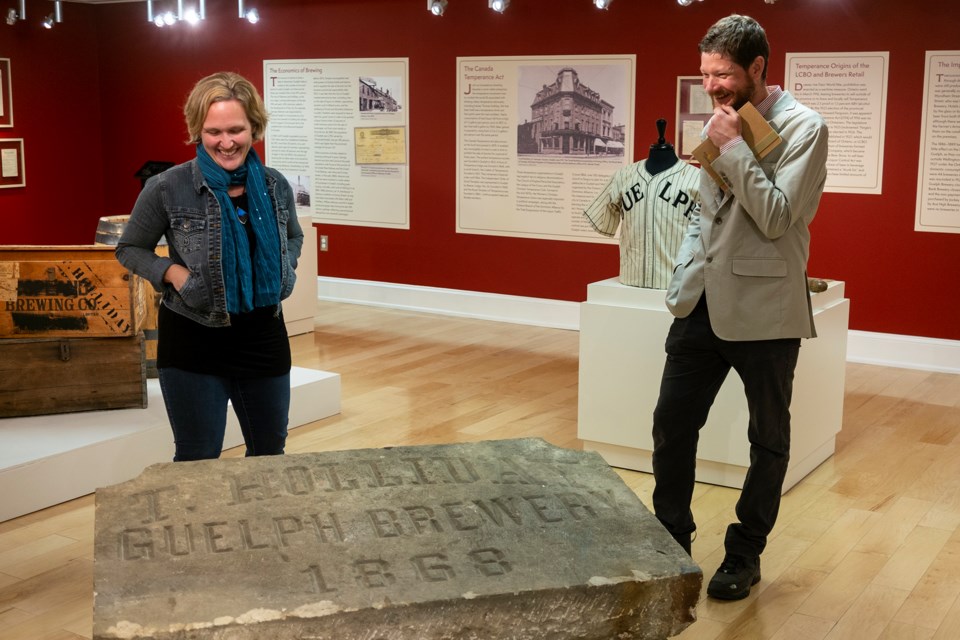When the Guelph Museum staff put out a call to the public for historical items for an exhibit about the city’s brewing history, they ended up acquiring a lost piece of a long-demolished early brewery — all 1,500 pounds of it.
The 'Brewing Changes Guelph' exhibit opens at the Guelph Civic Museum on Thursday. It examines the social and economic experience of brewing beer in the city from the mid-19th century to today.
“It’s not an overstatement to say beer built this town,” said Dawn Owen, curator of Guelph Civic Museum.
Owen said the early breweries were also instrumental in building the railroad and supporting recreational sports in the city.
Many people are aware of the early history of Sleeman Breweries in Guelph — in part because of a number of TV commercials the company ran — but fewer people are aware of the T Holliday Guelph Brewing, which was one of its contemporaries in the late 19th century until the 1930s.
“Holliday and Sleeman were the first commercially successful brewers in Guelph,” said Owen. Both breweries closed in the 1930s, but Sleeman was later resurrected in the 1980s.
After putting a call out to the public for pieces to be considered for the exhibit, the museum received a call from a woman in Paisley, Ont. who believed she had the keystone piece for the exhibit — literally.
The woman’s now-deceased husband saved a name stone from the Holliday brewery when it was demolished in the 1980s.
“He came and put it on the back of his pick up truck, drove it to Paisley, Ontario and it’s been sitting on their property for decades,” said Owen.
The museum has acquired the 1,500-pound stone not only for the exhibit, but for the its permanent collection, said Owen.
“Holliday is just as important in the early brewing history as Sleeman’s is, but we don’t have the benefit of having the everyday knowledge of Holliday and there aren’t as many artifacts still surviving,” said Owen. “We are hoping to collect the stories around a piece like this — what does that inspire? What memories do people have of Holliday Brewery?”
The exhibit is split over two levels in the museum, roughly splitting the story of brewing in Guelph into the early history from the mid-nineteenth century to the closure of the original Sleeman Breweries in 1939 on the main level, while the modern era of brewing in Guelph is presented on the second floor.
The resurrection of brewing in Guelph began in the 1980s, with the opening of Wellington County and Stonehammer breweries, and the opening of the new Sleeman Breweries after almost 50 years of there being no brewery in the city.
“Guelph became a brew town again, but it was a different kind of brew town — the trend of home brewing was building, not just in Guelph but around the world. People were interested again in beer and how to make it, how to drink it. There was a lot of experimentation,” said Owen.
The exhibit is guest curated by local historian and organic food advocate Eric Payseur. He said the exhibit speaks as much about his love of Guelph the city as it does his love of beer culture.
“Guelph is one of the most amazing places. I have lived north and south of the U.S.-Canadian border and on both sides of the Atlantic in many countries in Europe and there aren’t many places like Guelph,” said Payseur.
He said the collaborative nature of the brewing community in Guelph is unique, including Sleeman Breweries.
“I don’t think you’ll find another city in North America where there is a global conglomerate that owns a large-scale brewery that cooperates with craft brewers,” said Payseur. “You will not find a single craft brewer across Ontario that will have a negative thing to say about Sleeman, because the cross-population is enormous.”
The exhibit took about two and a half years to put together from inception to installation and includes artifacts sourced from a number of private collections and participation from all of the remaining local breweries.
“It really took a village to make this,” said Payseur.
One artifact the museum was not able to display is the closely-guarded original Sleeman family recipe book that founder John Sleeman used when resurrecting the brewery in the 1980s.
“We asked,” said Owen. “(Sleeman Breweries) has been amazingly supportive, but there are just some things that are closely-guarded family secrets.”
